Blog Information
- منشور من طرف : Nance David
- نشر على : Feb 20, 2025
- الآراء : 116
- الفئة : تقنية
- وصف : The Evolution of CCTV Cameras: From Analog to Smart Technology
نظرة عامة
- The Evolution of CCTV Cameras: From Analog to Smart Technology
The CCTV camera has undergone a remarkable transformation since its inception. Initially designed for basic surveillance, these devices have evolved into sophisticated tools that enhance security across various sectors. This article delves into the journey of CCTV cameras, highlighting their technological advancements and the impact on modern security systems.

Understanding the Basics of CCTV Cameras
A CCTV camera (Closed-Circuit Television) is a video camera used for surveillance purposes. Unlike traditional broadcast television, the signal is transmitted to a specific set of monitors. This technology was first introduced in the 1940s, primarily for monitoring rocket launches. Over the decades, its applications expanded significantly.
- Early systems utilized analog technology.
- Video footage was recorded on tapes.
- Limited resolution and functionality characterized these devices.
The Shift to Digital Technology
As technology progressed, the shift from analog to digital CCTV cameras became inevitable. Digital systems offered numerous advantages, including:
- Higher resolution images, enhancing clarity and detail.
- Improved storage options, allowing for longer retention of footage.
- Remote access capabilities, enabling users to monitor feeds from anywhere.
This transition marked a significant milestone in the evolution of CCTV cameras. With the advent of the internet, surveillance systems became more integrated and user-friendly.
Smart Technology and the Future of CCTV Cameras
Today, the integration of smart technology has revolutionized the CCTV camera landscape. Modern systems now incorporate features such as:
- Artificial Intelligence (AI) for facial recognition and anomaly detection.
- Cloud storage solutions for easy access and management of footage.
- Mobile applications that allow real-time monitoring and alerts.
These advancements not only enhance security but also provide users with greater control and flexibility. For instance, if a suspicious activity is detected, users can receive instant notifications on their smartphones.
Choosing the Right CCTV Camera for Your Needs
When selecting a CCTV camera, it is essential to consider various factors:
- Resolution: Higher resolution cameras provide clearer images.
- Field of View: A wider angle can cover more area.
- Night Vision: Essential for monitoring in low-light conditions.
By understanding these features, you can make an informed decision that best suits your security needs. For more information on advanced CCTV camera options, visit
 .
.Conclusion
The evolution of CCTV cameras from analog systems to smart technology reflects the broader trends in security and surveillance. As technology continues to advance, these devices will play an increasingly vital role in ensuring safety and security in our communities. Understanding this evolution not only highlights the importance of CCTV cameras but also prepares us for future innovations in the field.
